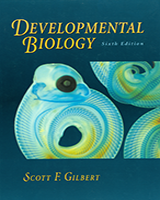By agreement with the publisher, this book is accessible by the search feature, but cannot be browsed.
NCBI Bookshelf. A service of the National Library of Medicine, National Institutes of Health.
Gilbert SF. Developmental Biology. 6th edition. Sunderland (MA): Sinauer Associates; 2000.

Developmental Biology. 6th edition.
Show detailsThroughout the animal kingdom, an incredible variety of embryonic types exist, but most patterns of embryogenesis are variations on five themes:
- 1.
Immediately following fertilization, cleavage occurs. Cleavage is a series of extremely rapid mitotic divisions wherein the enormous volume of zygote cytoplasm is divided into numerous smaller cells. These cells are called blastomeres, and by the end of cleavage, they generally form a sphere known as a blastula.
- 2.
After the rate of mitotic division has slowed down, the blastomeres undergo dramatic movements wherein they change their positions relative to one another. This series of extensive cell rearrangements is called gastrulation, and the embryo is said to be in the gastrula stage. As a result of gastrulation, the embryo contains three germ layers: the ectoderm, the endoderm, and the mesoderm.
- 3.
Once the three germ layers are established, the cells interact with one another and rearrange themselves to produce tissues and organs. This process is called organogenesis. Many organs contain cells from more than one germ layer, and it is not unusual for the outside of an organ to be derived from one layer and the inside from another. For example, the outer layer of skin comes from the ectoderm, while the inner layer (the dermis) comes from the mesoderm. Also during organogenesis, certain cells undergo long migrations from their place of origin to their final location. These migrating cells include the precursors of blood cells, lymph cells, pigment cells, and gametes. Most of the bones of our face are derived from cells that have migrated ventrally from the dorsal region of the head.
- 4.
As seen in Figure 2.1, in many species a specialized portion of egg cytoplasm gives rise to cells that are the precursors of the gametes (the sperm and egg). The gametes and their precursor cells are collectively called germ cells, and they are set aside for reproductive function. All the other cells of the body are called somatic cells. This separation of somatic cells (which give rise to the individual body) and germ cells (which contribute to the formation of a new generation) is often one of the first differentiations to occur during animal development. The germ cells eventually migrate to the gonads, where they differentiate into gametes. The development of gametes, called gametogenesis, is usually not completed until the organism has become physically mature. At maturity, the gametes may be released and participate in fertilization to begin a new embryo. The adult organism eventually undergoes senescence and dies.
- 5.
In many species, the organism that hatches from the egg or is born into the world is not sexually mature. Indeed, in most animals, the young organism is a larva that may look significantly different from the adult. Larvae often constitute the stage of life that is used for feeding or dispersal. In many species, the larval stage is the one that lasts the longest, and the adult is a brief stage solely for reproduction. In the silkworm moths, for instance, the adults do not have mouthparts and cannot feed. The larvae must eat enough for the adult to survive and mate. Indeed, most female moths mate as soon as they eclose from their pupa, and they fly only once—to lay their eggs. Then they die.
- The Circle of Life: The Stages of Animal Development - Developmental BiologyThe Circle of Life: The Stages of Animal Development - Developmental Biology
Your browsing activity is empty.
Activity recording is turned off.
See more...